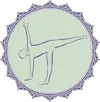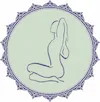![]()
animals & earth
THE YOGA TRADITION is one that brings the practitioner close to nature. One of our main duties as yogis is to remove obstacles that separate us from the divine spark that lies within all things. The most accessible forms to practice this principle with are the beings and things that exist all around us. We look for the similarities in the tree, the dog, the cat, and the cow, and by assuming those postures, we create relationships with the different embodied forms of life on earth.
As the story of the fish pose tells us, the very first yogi was Shiva. He is said to be the originator of the yoga tradition, and we honor him in many ways through our practice. One of the original forms of Shiva is Pashupati, the protector of the animals. Sharon Gannon and David Life, cofounders of Jivamukti Yoga, say that the yogi is the “original tree hugger,” the one who finds inherent value in remaining connected to the Earth, the plants, the animals, and all the beings and things that surround us on this planet. As Pashupati, Shiva walked softly among the beings of the earth, and they all saw him as a friend.
There is something powerful about allowing one’s heart to be so open that other beings can sense it. For the most part, human beings find it difficult to recognize this openness in others, but animals can sense it right away. They know instinctively whether someone is there to help or harm them.
Many yoga postures give us the opportunity to release fear from our hearts, including balance postures, which challenge our fear of falling; inversions, which challenge our fear of turning the world upside down; and backbends, which challenge our fear of fully opening to the moment. When fear exerts its grip, it can be an overpowering force that keeps us closed and therefore separated from the brilliant opportunities to connect that constantly surround us.
The lesson of how to become fearless always lies within the pose itself. Whether it’s through a rich story like that of Hanuman and his brave nature, or the simplicity of the dog that trusts its owner, or the crane that flies free and wild, we have much to learn from our fellow earthlings. Many of them exist without constant fear, going about their daily lives and instinctive habits without thinking, “Gosh, I wish I had done that differently.”
There’s a striking contrast between the way humans hold on to fear and the way animals freely let go of it. In the wild, when a tiger tries to feast on a gazelle, but just misses his catch, the spared gazelle doesn’t dwell on his near-fatal experience for weeks. He doesn’t run to all of his gazelle friends and recount the story, and he doesn’t stop going to the watering hole for fear of another attack. He simply shakes his whole body, literally moving the experience through his physical form, and goes about his life.
Asanas give us the opportunity to do just the same. We get the chance to move our life experience through our body by taking the shapes of the various forms in nature. We stretch and create space in our joints and muscles and do our best to embody the essence of each posture, learning its inherent lessons and experiencing freedom in that form. When this process takes hold and begins to release the fear from our body and our heart, we are able to live our lives joyfully, moment by moment. Fear lives in us as tension, and asana postures are designed to release tension from our bodies. The absence of tension is the absence of fear. And the absence of fear signifies the presence of joy, love, and open-heartedness. As we embody these shapes of nature, we learn to fall in love with the world around us.
![]()
matsyasana & matsyendrasana
FISH POSE
In matsyasana, or fish pose, the practitioner lies on the back, with legs extended and engaged and elbows drawn beneath the body. An inhale lifts the chest toward the ceiling, while the head drops back and the crown touches the floor. Just as there are many types of fish in the sea, there are many variations of this pose. In one variation the legs are in a lotus position, or a bound angle (baddha konasana) position. In another, the legs are lifted off the ground at a 45-degree angle to the floor, and the arms are lifted so they are parallel to the legs, with the palms pressing together. Alternatively, the supported version of this posture can be done by placing a block lengthwise between the shoulder blades and allowing the head to rest on a blanket. Matsyendrasana, described in the following pages, honors the fish in an altogether different pose.
The First Yoga Student
After ten thousand years of intense meditation, Shiva decided to descend from his seat upon Mount Kailash. As destroyer of the cosmos, Shiva rarely sees the need for personal upkeep, so he marched down the mountain, dreadlocked and encrusted with dirt, to find his beloved Parvati. As the consort of Shiva, Parvati has a lot of time for the particulars, and she had a feeling that this would be the day of Shiva’s return. So she packed a picnic and went to meet him at the river. As she was setting out lunch, her beloved arrived.
Shiva announced to Parvati that while he was upon his meditation seat, he discovered the most wondrous thing. After so many years of meditation, he was granted the key to the universe, the secret to salvation. He had discovered yoga, the path to ultimate union between the individual self and the divine source. As he went on an on about the amazing teachings he had conjured up on the mountaintop, Parvati continued fretting about lunch.
“Parvati, aren’t you listening to me?” exclaimed Shiva.
“What? Oh, sorry, my love. I’m just getting lunch ready.” Parvati coolly responded.
“But I’ve just made the discovery of a lifetime. Are you not interested in hearing about it?” Shiva asked, puzzled over her apparently flippant attitude about his great discovery.
“Of course I am. Please go on,” she simply replied.
So Shiva continued with his discourse on yoga: how it works, what kind of practices one can do to rediscover it, what a state of meditation is like, and how the individual contains a piece of the divine source. Little did Shiva know that Parvati had known about yoga for time immemorial and had been practicing in her own quiet, devout way for as long as she could remember. Somehow she had always assumed that Shiva knew about yoga, too, but had failed to mention it. While she was a bit surprised to learn that Shiva had only just “discovered” yoga, she was humble enough to let him have his moment and kept listening as Shiva rambled on about the glories of the practice.
Meanwhile, in the nearby river a fish was swimming downstream. Matsya (matsya is Sanskrit for “fish”) was a special fish who had a knack for listening carefully. As he swam by Shiva and Parvati he overheard some of Shiva’s remarks and decided to stay a little while and listen. He had never heard Shiva lecture on the nature of life and the universe before, and his words sounded important.
Shiva spoke, and Matsya listened. And as he listened, something magical began to happen. He felt the techniques and theory of yoga begin to take hold of his body and live inside of him. Through his perfect listening to Shiva’s instructions, Matsya became enlightened by the conclusion of Shiva’s discourse. At that moment, Shiva became the first guru (“teacher”) and Matsya became the first chela (“student”). They began the long lineage of teachers and students who successfully passed the teachings of yoga down through an oral tradition over thousands of years. Nothing in yoga is more important than this relationship, and through perfect listening, any good student can follow in the footsteps of Matsya....


















